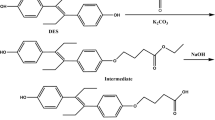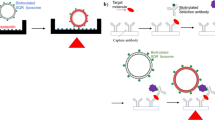Abstract
We have used the ligand binding domain of the recombinant human estrogen receptor (hER) to develop a nonisotopic assay for detection of estrogenic compounds. The assay is based on competition of the estrogenic ligand with 17β-estradiol for binding to the receptor, which leaves 17β-estradiol free to bind to an anti–17β-estradiol antibody. Unbound anti–17β-estradiol antibody then binds to immobilized 17β-estradiol–protein conjugate (to which hER is unable to bind for steric reasons), and is detected by an enzyme-labeled anti-rabbit IgG antibody. We used the assay to detect estrogenic compounds (mainly members of the flavonoid group of plant polyphenols) in a variety of commonly consumed plant foods.
This is a preview of subscription content, access via your institution
Access options
Subscribe to this journal
Receive 12 print issues and online access
$209.00 per year
only $17.42 per issue
Buy this article
- Purchase on Springer Link
- Instant access to full article PDF
Prices may be subject to local taxes which are calculated during checkout




Similar content being viewed by others
References
Wiese, T.E. & Kelce, W.R. An introduction to environmental oestrogens. Chemistry and Industry 24,648 –653 (1997).
Adlercreutz, H. Phytoestrogens: epidemiology and a possible role in cancer protection. Environ. Health Perspect. 103, 103– 112 (1995).
Anthony, M.S. et al. Soybean isoflavones improve cardiovascular risk factors without effecting the reproductive system of peripubertal rhesus monkeys. J. Nutr. 126, 43–50 ( 1996).
Evans, R.M. The steroid and thyroid receptor superfamily. Science 230, 889–895 (1988).
Obourn, J.D., Koszewski, N.J. & Angelo, C.N. Hormone and DNA binding mechanisms of the recombinant human estrogen receptor. Biochemistry 32, 6229–6236 (1993).
Seielstad, D.A., Carlson, K.E., Katzenellenbogen, J.A., Kushner, P.J. & Greene, G.L. Molecular characterisation by mass spectrometry of the human estrogen receptor ligand binding domain expressed in Escherichia coli. Mol. Endocrinol. 9, 647–658 (1995).
Miksicek, R.J. Interaction of naturally occurring nonsteroidal estrogens with expressed recombinant human estrogen receptor. J. Steroid Biochem. Mol. Biol. 49, 153–160 (1994).
Häggblad, J., Carlsson, B., Kivelä, P. & Siitari, H. Scintillating microtitration plates as platform for determination of [3H]-estradiol binding constants for hER-HBD. BioTechniques 18, 146–151 ( 1995).
Redeuilh, G., Secco, C. & Baulieu, E.E. The use of biotinyl estradiol-avidin system for the purification of nontransformed estrogen receptor by biohormonal affinity chromatography. J. Biol. Chem. 260, 3996– 4002 (1985).
Lewis, D.F.V., Parker, M.G. & King, R.J.B. Molecular modelling of the human estrogen receptor and ligand interactions based on site-directed mutagenesis and amino acid sequence homology. J Steroid Biochem. Mol. Biol. 52 , 55–65 (1995).
Liggins, J., Blurk, L.J.C., Coward, W.A. & Bingham, S.A. Extraction and quantification of daizein and geinstein in food. Anal. Biochem. 264, 1–7 (1998).
Seifert, M., Haindl, S. & Hock, B. Development of an enzyme linked receptor assay (ELRA) for estrogens and xenoestrogens. Anal. Chim. Acta 386 , 191–199 (1999).
Bolger, R., Wiese, T.E., Ervin, K., Nestich, S. & Checovich, W. Rapid screening of environmental chemicals for estrogen receptor binding capacity. Environ. Health Perspect. 106, 551–557 (1998).
Mosselman, S., Polman, J. & Dijkema, R. ERβ: identification and characterisation of a novel human estrogen receptor. FEBS Lett. 392, 49–53 (1996).
Kuiper, G.G.J.M. et al. Comparison of the ligand binding specificity and transcript tissue distribution of estrogen receptors α and β. Endocrinology 138, 863–870 ( 1997).
Clarkson, T.B., Anthony, M.S., Williams, J.K., Honoré, E.K. & Cline, J.M. The potential of soybean phytoestrogens for postmenopausal hormone replacement therapy. PSEBM 217, 365–368 (1998).
Jones, L.A. & Hajek, R.A. Effects of estrogenic chemicals on development. Environ. Health Persepect. 103, 63–67 (1995).
Miksicek, R.J. Estrogenic flavonoids: structural requirements for biological activity. Proc. Soc. Exp. Biol. Med. 208, 44– 50 (1995).
Coward, L., Barnes, N.C., Stechell, K.P.R. & Barnes, S. Genistein and daidzein and their β-glycoside conjugates: anti-tumour isoflavones in soybean foods of the American and Asian diets. J. Agric. Food Chem. 41, 1961–1967 (1993).
Wang, H-J. & Murphy, P.A. Isoflavone content in commercial soybean foods. J. Agric. Food Chem., 42, 1666–1673 (1994).
Soto, A.M. et al. The E-screen assay as a tool to identify estrogens: an update on estrogenic environmental pollutants. Environ. Health Perspect. 103, 113–122 (1995).
Creeke, P.I. et al. Development of enzyme-linked immunosorbent assays (ELISAs) for the measurement of the dietary phytoestrogens daidzein and equol in human plasma. Food Agric. Immunol. 10, 325– 337 (1998).
Lapcik, O. et al. Radioimmunoassay of free genistein in human serum. J. Steroid Biochem. Mol. Biol. 64, 261–268 ( 1998).
Murphy, P.A., Song, T., Buseman, G. & Barua, K. Isoflavones in soy-based infant formulas. J. Agric. Food Chem. 45, 4635– 4638 (1997).
Erlanger, B.F., Borek, F., Beisner, S.H. & Libermans, S. Steroid–protein conjugates -1. Preparation and characterisation of conjugates of bovine serum albumin with testosterone and cortisone. J. Biol. Chem. 228, 713–727 (1958).
Acknowledgements
The financial support of the Ministry of Agriculture, Fisheries, and Food is gratefully acknowledged. We thank Elif Buyukpamukcu for making the 17β–estradiol–BTG conjugate; Geoffrey Greene of the Ben May Institute, University of Chicago for providing the GST–LBD plasmid; Jason Liggins of the Dunn Nutrition Centre, University of Cambridge, UK, for helpful discussions and isoflavone measurements of some foods; Keith Price of the Institute of Food Research (Norwich, UK) for valuable discussions on flavonoids in foods; and Hugh Makin of Queen Mary & Westfield College, University of London, London, UK, for helpful discussions and his support.
Author information
Authors and Affiliations
Corresponding author
Rights and permissions
About this article
Cite this article
Garrett, S., Lee, H. & Morgan, M. A nonisotopic estrogen receptor–based assay to detect estrogenic compounds. Nat Biotechnol 17, 1219–1222 (1999). https://doi.org/10.1038/70773
Received:
Accepted:
Issue Date:
DOI: https://doi.org/10.1038/70773
This article is cited by
-
Ultrasensitive detection of endocrine disruptors via superfine plasmonic spectral combs
Light: Science & Applications (2021)
-
Detection of environmental chemicals by SPR assay using branched cyclodextrin as sensor ligand
Journal of Inclusion Phenomena and Macrocyclic Chemistry (2007)
-
Surface plasmon resonance-based immunoassay for 17?-estradiol and its application to the measurement of estrogen receptor-binding activity
Analytical and Bioanalytical Chemistry (2005)
-
Detecting estrogens in food and the environment
Nature Biotechnology (1999)



